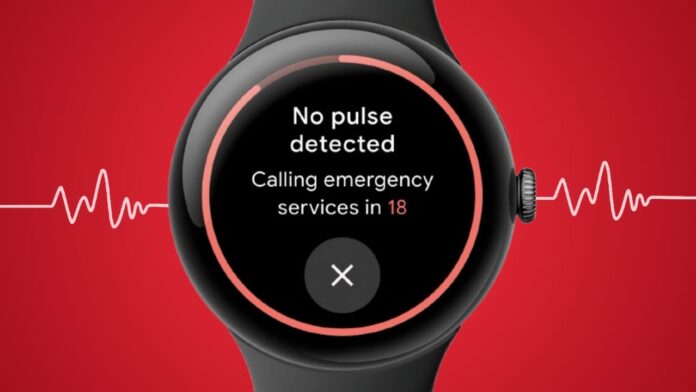
Google has introduced an advanced safety feature called Loss of Pulse Detection with the Pixel Watch 3. This unique health feature automatically calls emergency services when it detects no pulse.
It can save lives during a cardiac emergency. Here, I will explain how to Use Loss of Pulse Detection on the Pixel Watch 3 and why it’s an important feature for every user.
Understanding the Loss of Pulse Detection Feature
The Pixel Watch 3 is Google’s most advanced smartwatch. It comes with improved hardware, better battery life as well as top-class health sensors. Loss of Pulse Detection is its one of the best health features. It is designed to help during heart emergencies by detecting the absence of a pulse.
The watch uses advanced optical heart sensors to check your pulse continuously. If the system fails to find a heartbeat, it assumes that something serious has happened. Once confirmed, it automatically calls emergency services for help.
The Pixel Watch 3 shares your real-time location with them. It also plays an automated message that says your watch cannot detect a pulse and you are unresponsive.
The watch takes several steps before calling emergency services to avoid false alarms. It first vibrates gently to check your response. If you move your wrist or your pulse returns, the alert stops immediately. You can also tap “I’m OK” to cancel the alert manually.
If there is still no response after 15 seconds, the watch plays a loud sound for 20 seconds. During this time, you can cancel the emergency call by tapping the “X” icon.
If no action is taken, the call automatically connects to emergency services. Anyone nearby can also speak directly to the operator by tapping the screen once the call begins.
This system is designed to be smart, reliable, and life-saving. It ensures that help reaches you quickly if you lose consciousness or suffer a cardiac event.
How to Use Loss of Pulse Detection on the Pixel Watch 3
Setting up the Loss of Pulse Detection feature is easy. However, it’s not turned on automatically. You must enable it manually after updating your apps and system. Follow these steps carefully to use it properly.
Step 1: Update Your Pixel Watch 3 and Phone
Make sure your Pixel Watch 3 runs on the latest Wear OS 15.1 version. Also, your connected Pixel phone should be updated to Android 15. Update the Pixel Watch app and the Personal Safety app on both devices. Without these updates, the feature might not appear.
Step 2: Open the Personal Safety App on the Watch
On your Pixel Watch 3, open the Personal Safety app. Scroll down until you see Loss of Pulse Detection. Tap on it. If you don’t see the option, restart your watch and check again. Make sure your region supports the feature.
Step 3: Use the Pixel Watch App on Your Phone
Now open the Pixel Watch app on your paired phone. Go to Safety & Emergency. Tap Loss of Pulse Detection from the list. If it’s not available, ensure you are in a supported region and have the latest versions of the apps.
Step 4: Review the Instructions
You will see detailed information about how the feature works. Read the instructions carefully and tap Continue to move forward.
Step 5: Verify Eligibility
You will be asked to enter your date of birth and answer a yes or no question about eligibility. Once done, tap Continue to proceed to the next step.
Step 6: Review Privacy Details
Google will show information about data usage and limitations. Review both screens carefully. Then tap Continue again.
Step 7: Turn On the Feature
The last screen will show Things to Remember. It lists all important details about how the feature operates. Scroll to the bottom and tap Turn On. Once done, the feature will activate immediately.
Now your Pixel Watch 3 will start monitoring for pulse loss whenever you wear it.
Supported Devices and Regions
The Loss of Pulse Detection feature is exclusive to the Google Pixel Watch 3. It is not available on older Pixel Watch models. This is because the Pixel Watch 3 includes a new, more accurate multipath heart rate sensor that improves pulse tracking.
The feature works on both Wi-Fi and LTE versions of the watch. However, there’s an important difference between the two:
- The Wi-Fi version can make emergency calls only if it’s connected via Bluetooth to your paired smartphone.
- The LTE version can contact emergency services directly, even without an active cellular plan in many regions.
This feature is currently available in several countries, including:
- Austria
- Belgium
- Denmark
- France
- Germany
- Ireland
- Italy
- Netherlands
- Norway
- Portugal
- Spain
- Sweden
- Switzerland
- United Kingdom
- United States
Google is working to bring this feature to more regions soon. However, availability depends on your physical location, not your Google account or purchase region.
If you travel to a country where the feature is not supported, it will automatically pause. For example, if you live in the U.S. and travel to Canada, it will remain inactive. Once you return to a supported country, it will turn back on automatically.
How the Feature Helps During Emergencies
The Loss of Pulse Detection feature works silently in the background. It uses high-accuracy sensors to check your pulse continuously. If your heart stops or your pulse drops suddenly, the system takes over immediately.
Here’s how it keeps you safe:
- Detects pulse loss quickly and accurately.
- Vibrates softly to confirm your status.
- Play loud sounds before making a call.
- Send your exact location to emergency responders.
- Works automatically even when you’re unconscious.
- Cancels false alerts if pulse or movement returns.
This technology is similar to Google’s fall detection and crash detection features but focuses only on your heart. It’s designed to help during cardiac emergencies when every second counts.
The feature adds peace of mind for people with heart-related health issues or those who live alone. It ensures that someone will be alerted instantly if you face a serious health issue.
Why It’s an Important Step for Smartwatch Safety
The Loss of Pulse Detection feature is a major milestone in smartwatch safety. No other smartwatch brand, including Apple or Samsung, currently offers this feature. Google became the first to introduce it after receiving approval from the U.S. FDA in 2025.
It highlights Google’s growing focus on health technology. While most smartwatches monitor heart rate or blood oxygen, the Pixel Watch 3 goes one step further. It acts like a guardian that can call for help when you cannot.
The feature not only adds value to the watch but also builds trust among users. It represents the next step in wearable technology — combining convenience, health, and safety in one device.
Tips for Best Results
To make sure the feature works correctly, follow these tips:
- Wear your watch snugly on your wrist.
- Keep the sensors clean and dry.
- Update all apps regularly.
- Ensure your location services are turned on.
- Use the LTE version for better emergency performance.
- Check regional availability before traveling.
These small steps ensure that Loss of Pulse Detection functions smoothly and accurately when needed.
The Future of Pixel Watch Health Features
Google continues to improve its health-focused smartwatch lineup. The first Pixel Watch had limited health features. The Pixel Watch 2 improved battery and fitness tools. The Pixel Watch 3 now leads the market with medical-grade detection systems.
Future versions may include more advanced sensors and additional safety features. Google may also expand its global availability and add deeper integration with health apps.
This shows how serious Google is about using technology to improve human safety and well-being.
As We Conclude
The Loss of Pulse Detection feature on the Pixel Watch 3 is a game-changing innovation in smartwatch safety. It automatically detects pulse loss and contacts emergency services when needed.
With simple setup steps, advanced sensors, and wide regional support, it’s a must-have feature for every user. If you own a Pixel Watch 3, enable it today, it could save your life.







